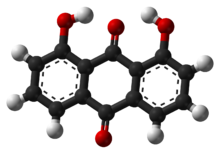 | |
 | |
| Clinical data | |
|---|---|
| Routes of administration | Oral, rectal (enema) |
| ATC code | |
| Identifiers | |
| |
| CAS Number | |
| PubChem CID | |
| DrugBank | |
| ChemSpider | |
| UNII | |
| KEGG | |
| ChEBI | |
| ChEMBL | |
| NIAID ChemDB | |
| CompTox Dashboard (EPA) | |
| ECHA InfoCard | 100.003.794 |
| Chemical and physical data | |
| Formula | C14H8O4 |
| Molar mass | 240.214 g·mol−1 |
| 3D model (JSmol) | |
| Density | 1.575 g/cm3 g/cm3 |
| |
| |
| | |
Dantron (INN), also known as chrysazin or 1,8-dihydroxyanthraquinone, is an orange-colored organic substance. Many structurally-related compounds are known.[1] In terms of its molecular structure, it is related anthraquinone by the replacement of two hydrogen atoms by hydroxyl groups (–OH). It is used in some countries as a stimulant laxative.
It should not be confused with ondansetron, an unrelated drug that was marketed in South Africa under the trade name "Dantron".
- ^ Rohl AL, Moret M, Kaminsky W, Claborn K, McKinnon JJ, Kahr B (2008). "Hirshfeld Surfaces Identify Inadequacies in Computations of Intermolecular Interactions in Crystals: Pentamorphic 1,8-Dihydroxyanthraquinone". Crystal Growth & Design. 8 (12): 4517–4525. doi:10.1021/cg8005212.